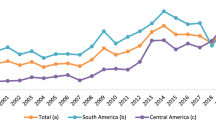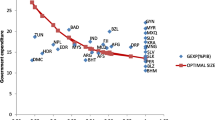Abstract
This paper aims not only to measure the relative efficiency of government spending in seven Asian countries but also to investigate the factors that influence government performance using annual data covering the period 1986–2007. Four hypotheses are tested: (i) the effect of private sector activities on the inefficiency of government spending in raising GDP, (ii) the government corruption hypothesis, (iii) the government size hypothesis, and (iv) the relationship between monetary expansion and the performance of government spending. The results of data envelopment analysis (DEA) show that Japan and Singapore have the highest efficiency scores in the sample. Extreme bounds analysis (EBA) in association with Tobit regression indicates that private sector activities exhibit a robust negative relationship with government inefficiency. Corruption is found to be a crucial factor affecting government performance, and M2 expansion and the inefficiency of government spending are robustly positively related.
Similar content being viewed by others
References
Banker, R.D. Charnes, A. and Cooper, W.W., 1984. Some models for estimating technical and scale inefficiency in data envelopment analysis. Management Science, 30(9), pp. 1078–1092.
Bardhan, P., 1997. Corruption and development: A review of issues. Journal of Economic Literature, 35(3), pp.1320–1346.
Barreto, R.A., 2000. Endogenous corruption in a neoclassical growth model. European Economic Review, 44(1), pp.35–60.
Barro, R.J., 1990. Government spending in a simple model of endogenous growth. Journal of Political Economy, 98(5), S103–S125.
Barro, R.J., 1991. Economic growth in a cross section of countries. Quarterly Journal of Economics, 106(2), pp.407–443.
Blanchard, O. and Perotti, R., 2002. An empirical characterization of the dynamic effects of changes in government spending and taxes on output. Quarterly Journal of Economics, 117(4), pp.1329–1368.
Bose, N., Haque, M.E. and Osborn, D., 2007. Public expenditure and economic growth: A disaggregated analysis for developing countries. The Manchester School, 75(5), pp.533–556.
Bose, N., Capasso, S. and Murshid, A.P., 2008. Threshold effects of corruption: Theory and evidence. World Development, 36(7), pp.1173–1191.
Cebula, R.J., 2003. Budget deficits and interest rates in Germany. International Advances in Economic Research, 9(1), pp.64–68.
Charnes, A., Cooper, W.W. and Rhodes, E., 1978. Measuring the efficiency of decision making units. European Journal of Operational Research, 2(6), pp.429–444.
Coelli, T., Rao, D.S.P. and Battese, G.E., 1998. An introduction to efficiency and productivity analysis. Boston: Kluwer Academic Publishers.
Cooley, T.F. and LeRoy, S.F., 1981. Identification and estimation of money demand. American Economic Review, 71(5), pp.825–844.
Dernburg, T., 1992. A note on data corruption and monetary-fiscal policy regimes. Journal of Economics and Finance, 16(2), pp.147–153.
Easterly, W. and Rebelo, S., 1993. Fiscal policy and economic growth: An empirical investigation. Journal of Monetary Economics, 32(3), pp.417–458.
Evans, P. and Karras, G., 1996. Private and government consumption with liquidity constraints. Journal of International Money and Finance, 15(2), pp.255–266.
Faria, J.R., 2000. A two-class fiscal and monetary growth model, Structural Change and Economic Dynamics, 11(3), pp.355–364.
Farrell, M.J., 1957. The measurement of productive efficiency. Journal of the Royal Statistical Society, Series A, General, 120, pp.253–281.
Folster, S. and Henrekson, M., 2001. Growth effect of government expenditure and taxation in rich countries. European Economic Review, 45(8), pp.1501–1520.
Fox, K.J., 2002. Performance assessment in the public sector. In: KJ. Fox, ed., Efficiency in the public sector. Boston: Kluwer Academic Publishers. Ch.1.
Fried, H.O. Schmidt, S.S. and Yaisawarng, S., 1999. Incorporating the operating environment into a nonparametric measure of technical efficiency. Journal of Productivity Analysis, 12(3), pp.249–267.
Greene, W.H., 1981. On the asymptotic bias of the ordinary least squares estimator of the Tobit model. Econometrica, 49(2), pp.505–513.
Grigor’ev, L. and Ovchinnikov, M., 2009. Corruption as an obstacle to modernization. Problems of Economic Transition, 51(11), pp.40–61.
Hansson, P. and Henrekson, M., 1994. A new framework for testing the effect of government spending on growth and productivity, Public Choice, 81(3/4), pp.381–401.
Hsu, Y.C. and Lee, M.S., 2009. The effect of consumer voucher to increase GDP by 0.66% to 1%. United Daily News, [online] Available at: <http://udn.com/NEWS/NATIONAL/NATS1/4699235.shtmls[Accessed on January 20, 2009]. (in Chinese).
Hwang, I. and Wang, E.C., 2008. The effectiveness of export, FDI, and R&D on total factor productivity growth: The case of Taiwan and Korea. Social Science Research Institute, Monograph Series 14, International Christian University, Tokyo, Japan.
Kandil, M. and Mirzaie, I.A., 2006. Consumption and macroeconomic policies: Theory and evidence from developing countries. Journal of International Trade and Economic Development, 15(4), pp.469–491.
Kolluri, B. and Wahab, M., 2007. Asymmetries in the conditional relation of government expenditure and economic growth. Applied Economics, 39(18), pp.2303–2322.
Kwan, C.H., 1996. A new wave of foreign direct investment in Asia. In: DK. Das, ed. Emerging growth pole: The Asia-Pacific economy. N.Y.: Prentice Hall.
Leamer, E.E., 1983. Let’s take the con out of econometrics. American Economic Review, 73(1), pp.31–43.
Leamer, E.E., 1985. Sensitivity analyses would help. American Economic Review, 75(3), pp.308–313.
Leightner, J.E., 2002. The productivity of government spending in Asia: 1983–2000. In: The Third Asian Conference, Efficiency and Productivity Growth, Taipei, Taiwan, R.O.C., 12 July 2002.
Levine, R. and Renelt, D., 1992. A sensitivity analysis of cross-country growth regressions. American Economic Review, 82(4), pp.942–963.
Lovell, C.A.K., Pastor, J.T. and Turner, J.A., 1995. Measuring macroeconomic performance in the OECD: A comparison of European and non-European countries. European Journal of Operational Research, 87(3), pp.507–518.
Lu, S.H., 2009. Legislative Yuan passed the budget bill for expanding public infrastructure construction to NTD149.1 billions. Central Broadcasting Station, 10 April. (in Chinese)
Mankiw, N.G., Romer, D. and Weil, D.N., 1992. A contribution to the empirics of economic growth. Quarterly Journal of Economics, 107(2), pp.407–437.
Marini, G. and van der Ploeg, F., 1988. Monetary and fiscal policy in an optimizing model with capital accumulation and finite lives. Economic Journal, 98(392), pp.772–786.
McDonald, J. and Moffitt, R., 1980. The uses of Tobit analysis. Review of Economics and Statistics, 62(2), pp.318–321.
Miller, S.M. and Upadhyay, M.P., 2000. The effects of openness, trade orientation, and human capital on total factor productivity. Journal of Development Economics, 63(2), pp.399–423.
Neyapti, B., 2003. Budget deficit and inflation: The roles of central bank independence and financial market development. Contemporary Economic Policy, 21(4), pp.458–475.
Parkin, M., 2009. Economics. 9th ed. Boston: Pearson.
Polokangas, T., 1993. Temporary cuts in government spending as an anti-inflation device. Economic Letter, 43(2), pp.199–203.
Rayp, G. and Van De Sijpe, N., 2007. Measuring and explaining government efficiency in developing countries. Journal of Development Studies, 43(2), pp.360–381.
Rosenstein-Rodan, P., 1943. Problems of industrialization of eastern and southeastern Europe. Economic Journal, 53(210/211), pp.202–211.
Saleh, A. and Harvie, C., 2005. The Budget deficit and economic performance: A survey. The Singapore Economic Review, 50(2), pp.211–243.
Setterfield, M., 2009. Fiscal and monetary policy interactions: lessons for revising the EU stability and growth pact. Journal of Post-Keynesian Economics, 31(4), pp.623–643.
Treisman, D., 2000. The causes of corruption: A cross-national study. Journal of Public Economics, 76(3), pp.399–457.
Wang, E.C. and Huang, W.C., 2007. Relative efficiency of R&D activities: A cross-country study accounting for environmental factors in the DEA approach. Research Policy, 36(2), pp.260–273.
Wang, E.C., 2010. Determinants of R&D investment: The extreme-bound-analysis approach applied to 26 OECD countries. Research Policy, 39(1), pp.103–116.
Ward, A. and Beattie, A., 2009. Obama to take his plan to the people. Financial Times, 6 Feb.
Yaisawarng, S., 2002. Performance measurement and resource allocation. In: K.J. Fox, Efficiency in the public sector. Boston: Kluwer Academic Publishers. Ch.3.
Young, P.C. and Pedregal, D.J., 1999. Macro-economic relativity: Government spending, private investment and unemployment in the USA, 1948–1998. Structural Change and Economic Dynamics, 10(3–4), pp.359–380.
Author information
Authors and Affiliations
Corresponding author
Additional information
We would like to thank the editor of this journal and an anonymous referee for helpful comments and criticisms. We would also like to thank the conference participants at the EBES 2010-Istanbul and to G. Y. Chen and C.S.P. Yao for research assistance. All errors and omissions are ours.
Rights and permissions
About this article
Cite this article
Wang, E.C., Alvi, E. Relative Efficiency of Government Spending and Its Determinants: Evidence from East Asian Countries. Eurasian Econ Rev 1, 3–28 (2011). https://doi.org/10.14208/BF03353822
Published:
Issue Date:
DOI: https://doi.org/10.14208/BF03353822




